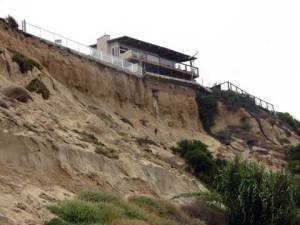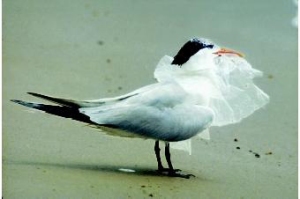During my recent field trip with Ms. McCarron’s Oceanography class we attended Plum Island beach and other sites as well. While on my trip to the beach I observed many different species of plants. These plants included beach grass, dusty miller, different sea weeds, golden rods, and other plants. As I studied these plants I realized that they had all adapted to their environments. The plants were sturdy and could handle the winds of the beach and the salty sea water as well. While on the beach, I also saw some animal life. The animals I saw were crabs, oysters, muscles and seagulls too. Seeing these animals left me thinking about how beaches are affected by us humans “invading” their homes. Overall, there are many ways that beaches are affected by humans and I observed many of these while on the field trip.
One way that beaches are being affected by humans is the development of houses on beaches. These houses are disturbing the natural habitats of beaches by adding human interaction that wouldn’t normally be so close to beach plants and wildlife. Also these houses are having problems caused by the beaches as well. The natural erosion of sand on beaches by the waves is causing houses to be literally falling into the ocean. In an effort to stop this erosion, barriers or Sea Walls are often built, but these walls can actually cause more damage as they can add waste to the beach as the walls break and even in some cases cause more erosion than before. Another way humans are impacting beaches is by collecting and hunting wildlife. As humans collect shells they could possibly be taking away the “new” home for a crab that has outgrown its shell and may be in search of a new one. Then in the case of hunting wildlife, this would be activities such as fishing that could be depleting a certain type of fish in the sea. Thus taking a way an organism that is a vital part to the ocean’s ecosystem as a species and a source of food for other organisms. A final effect of humans on beaches is pollution. This waste would be any trash that humans leave behind on the beaches as this will affect the wildlife. Animals such as seagulls can easily mistake trash for food and can choke in an attempt to eat said “food.” Animals can also become easily entangled in plastic bags. Another waste I actually observed on the beach was small white disks spread throughout the plant life. After some further questioning I came to find these were indeed biohazard disks. From further research I’ve learned that there were similar disks found on Hampton and Salisbury beach from a wastewater plant. This could be the cause of the disks on Plum Island or just a similar case, either way the impact of this biohazardous waste on the Beach is grave to the wildlife and their environment. All in all, there are many ways that humans impact beach wildlife, plant life, and environment.
So overall, my observations and research on the human effects on beaches relates to the study of Oceanography greatly. The way that humans interact with beaches affects wildlife and oceans as well. Humans’ negative impacts on beaches such as overhunting, development, and human waste all leave a mark on the oceans that are an important part of our planet. Oceans provide humans with a source of food, business, and a beautiful place to relax. Oceans also play an important part in the natural balance of the Earth and our lives. In the end, human interactions with beaches and oceans relates to the study of Oceanography as a whole because the way we interact with the beaches has effects on Oceans and the Earth as a whole.
Posts Tagged ‘plants’
Human Effects on Beaches
Posted in Uncategorized, tagged beaches, erosion, Flora, Oceanography, plants, Plum Island, Wildlife on October 14, 2011| 14 Comments »
One with Nature
Posted in Ecology, Nature, tagged Animals, Aquatic Ecosystems, Flowers, food chain, plants, wild nature on May 10, 2010| Leave a Comment »
On our walk around the pond, we observed many different types of plant, animals, and trees. We looked at our pond in front of our school. The pond was mucky and dirty but with many frog in it. If the muck was removed from the pond it would look crystal clear but nothing would be able to live in it. We saw many frogs around the pond and if their entire habitat was removed they would not be able to strive. There *food chain might be altered if their environment is changed. We also observed many dandelions all over the fields. They were every where and we picked them and Calvin put them in his shirt.

http://www.youtube.com/watch?v=6EcvgZyQvLo
*http://en.wikipedia.org/wiki/Food_chain
AlexanderM.
Pond Ecosystem
Posted in Ecology, Nature, Pond, Wildlife, tagged Aquatic Ecosystems, plants, wild nature on May 10, 2010| 1 Comment »
At the school pond I noticed that despite the algae there were fish, frogs, and various plants. I thought algae in ponds or lakes was bad for the other life in that pond or lake. Maybe there is not enough to kill the other life, but just enough to create food for the fish and birds. There probably is enough primary consumers to keep it in check. I tried to catch a frog, but the algae and other plant matter provided good cover. If there are so many frogs, I bet there are many flies to feed them.
Jacques L.
Animal In the Wild
Posted in Nature, tagged Animals, backyard, bees, birds, chipmunk, grass, plants, tree, wild nature on May 10, 2010| Leave a Comment »
Today, I went to the backyard because it looked like a nice day. When I got outside it was really windy and I could see the leaves being blown all around and I could see birds flying everywhere along with bees. The bees were huge, not sure what exactly they were, and they kept flying around looking like they were about to fall down. They kept going flower to flower which I think was probably them spreading nectar from flower to flower. The bees get food from the nectar of the flowers. I saw chipmunks running in the grass and even up trees. I’m guessing the chipmunks live in the trees as over the course of an hour I went outside again and continued to see random chipmunks running to and from the tree. If there was no tree I’m pretty sure the random birds would swoop down and catch one of those critters. It’s hard to tell because anything can happen in the wild. For all I know, the chipmunks might eat the birds! No one really knows what will happen but can only presume what will based on their prior knowledge. There seems to be a swampy place behind the fence. Not really a swamp but the land there seems wet. I heard a random sound. It sounded like something ran past the plants that look like the plants you see where lions live. I checked out what it could be but when I got there it was gone. On the lookout now for what animal is living in the swamp area.
Alex H.





